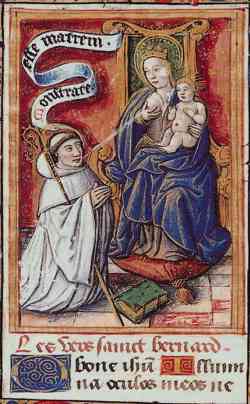Nursing Madonna
Nursing Madonna
The term Nursing Madonna refers to artistic depictions of the Virgin Mary breastfeeding the Infant Jesus. These representations are also known as Madonna Lactans or Maria Lactans. The imagery of the Nursing Madonna has been a significant theme in Christian art since the early centuries of the Christian era.
Historical Context[edit | edit source]
The earliest known depictions of the Nursing Madonna date back to the Catacombs of Rome, where early Christians used this imagery to emphasize the humanity and maternal aspects of Mary. During the Middle Ages, the Nursing Madonna became a popular subject in Byzantine art and later in Renaissance art.
Symbolism[edit | edit source]
The Nursing Madonna symbolizes the nurturing and maternal qualities of the Virgin Mary. It also represents the Incarnation, highlighting the human nature of Jesus Christ. The act of breastfeeding is seen as a symbol of divine nourishment and the sustenance provided by the Church.
Artistic Representations[edit | edit source]
Throughout history, various artists have depicted the Nursing Madonna in different styles and contexts. Notable examples include:
- Madonna Litta by Leonardo da Vinci
- Madonna and Child by Rogier van der Weyden
- Madonna del Latte by Ambrogio Lorenzetti
Cultural Impact[edit | edit source]
The Nursing Madonna has had a profound impact on Christian iconography and has been a source of inspiration for many artists. It has also influenced the portrayal of motherhood and the role of women in religious contexts.
Related Pages[edit | edit source]
- Virgin Mary
- Infant Jesus
- Christian art
- Byzantine art
- Renaissance art
- Madonna and Child
- Incarnation (Christianity)
Categories[edit | edit source]
This article is a Christianity-related stub. You can help WikiMD by expanding it!
Search WikiMD
Ad.Tired of being Overweight? Try W8MD's physician weight loss program.
Semaglutide (Ozempic / Wegovy and Tirzepatide (Mounjaro / Zepbound) available.
Advertise on WikiMD
|
WikiMD's Wellness Encyclopedia |
| Let Food Be Thy Medicine Medicine Thy Food - Hippocrates |
Translate this page: - East Asian
中文,
日本,
한국어,
South Asian
हिन्दी,
தமிழ்,
తెలుగు,
Urdu,
ಕನ್ನಡ,
Southeast Asian
Indonesian,
Vietnamese,
Thai,
မြန်မာဘာသာ,
বাংলা
European
español,
Deutsch,
français,
Greek,
português do Brasil,
polski,
română,
русский,
Nederlands,
norsk,
svenska,
suomi,
Italian
Middle Eastern & African
عربى,
Turkish,
Persian,
Hebrew,
Afrikaans,
isiZulu,
Kiswahili,
Other
Bulgarian,
Hungarian,
Czech,
Swedish,
മലയാളം,
मराठी,
ਪੰਜਾਬੀ,
ગુજરાતી,
Portuguese,
Ukrainian
Medical Disclaimer: WikiMD is not a substitute for professional medical advice. The information on WikiMD is provided as an information resource only, may be incorrect, outdated or misleading, and is not to be used or relied on for any diagnostic or treatment purposes. Please consult your health care provider before making any healthcare decisions or for guidance about a specific medical condition. WikiMD expressly disclaims responsibility, and shall have no liability, for any damages, loss, injury, or liability whatsoever suffered as a result of your reliance on the information contained in this site. By visiting this site you agree to the foregoing terms and conditions, which may from time to time be changed or supplemented by WikiMD. If you do not agree to the foregoing terms and conditions, you should not enter or use this site. See full disclaimer.
Credits:Most images are courtesy of Wikimedia commons, and templates, categories Wikipedia, licensed under CC BY SA or similar.
Contributors: Prab R. Tumpati, MD






